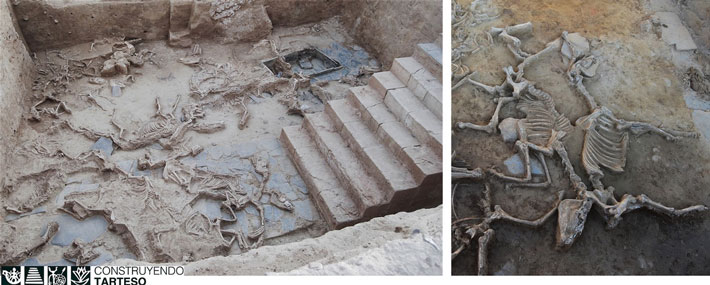 BADAJOZ, SPAIN—According to a Cosmos Magazine report, researchers led by Pilar Iborra Eres of the Valencian Institute of Conservation, Restoration, and Research have analyzed thousands of bones unearthed in western Spain, in the courtyard of Casas del Turuñuelo, a large structure built by the Tartessian culture. The study dated the remains to the end of the fifth century B.C., and determined that the bones came from at least 52 animals, including more than 40 horses or other equids, six cows, four pigs, and one dog. Most of the horses and cows were male, while most of the pigs were female. In the earliest layers of the site, the researchers noted that the animal remains were largely intact, indicating that they had not been consumed. Fire may have also been part of the ritual sacrifice, since charcoal and charred organic matter were recovered in these layers. Fewer animal remains were found in the more recent layers of the site. These had been butchered, presumably for human consumption. Goods imported from the eastern Mediterranean, such as ointment jars, bowls, and a Greek marble sculpture, were also found in this layer. The entire structure of Casas del Turuñuelo was eventually ritually destroyed by fire. Read the original scholarly article about this research in PLOS ONE. To read about a Roman mosaic uncovered in Spain, go to "The Medusa of Mérida."
BADAJOZ, SPAIN—According to a Cosmos Magazine report, researchers led by Pilar Iborra Eres of the Valencian Institute of Conservation, Restoration, and Research have analyzed thousands of bones unearthed in western Spain, in the courtyard of Casas del Turuñuelo, a large structure built by the Tartessian culture. The study dated the remains to the end of the fifth century B.C., and determined that the bones came from at least 52 animals, including more than 40 horses or other equids, six cows, four pigs, and one dog. Most of the horses and cows were male, while most of the pigs were female. In the earliest layers of the site, the researchers noted that the animal remains were largely intact, indicating that they had not been consumed. Fire may have also been part of the ritual sacrifice, since charcoal and charred organic matter were recovered in these layers. Fewer animal remains were found in the more recent layers of the site. These had been butchered, presumably for human consumption. Goods imported from the eastern Mediterranean, such as ointment jars, bowls, and a Greek marble sculpture, were also found in this layer. The entire structure of Casas del Turuñuelo was eventually ritually destroyed by fire. Read the original scholarly article about this research in PLOS ONE. To read about a Roman mosaic uncovered in Spain, go to "The Medusa of Mérida."
Iron Age Animal Sacrifices Studied in Spain
